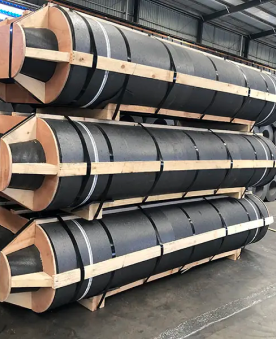Graphite electrodes are an essential component of the steel-making process, used to melt steel scrap and other materials in electric furnaces (EAFs). These electrodes are made from high-purity graphite and play a critical role in converting raw materials into high-quality steel products. The production process for graphite electrodes begins with the selection of high-quality petroleum coke and needle coke. These materials are crushed, ground, and mixed with a binder to form a paste. The paste is then extruded into the desired shape and size and baked at high temperatures to remove the binder and convert the paste into solid graphite. The resulting graphite blocks are then machined and threaded to create the final product. Graphite electrodes are used in the steel industry for several reasons. First, they are able to withstand the extremely high temperatures generated in EAFs, which can reach up to 3,500 degrees Celsius. Second, they have a high thermal conductivity, which allows them to efficiently transfer heat to the steel melt. Finally, they have a low coefficient of thermal expansion, which means they do not expand or contract significantly with changes in temperature, ensuring a stable and consistent performance. There are several important use cases for graphite electrodes in the steel industry. One of the primary applications is in the production of steel from scrap metal. In this process, steel scrap is melted in an EAF using graphite electrodes, which supply the electrical current needed to heat the scrap to melting temperature. The resulting liquid steel can then be cast into a variety of shapes and forms. Graphite electrodes are also used in the production of specialty steels, such as stainless steel and tool steel. These materials require a higher degree of precision and control in the melting process, which graphite electrodes can provide. In addition, graphite electrodes are used in the production of ferroalloys, which are alloys of iron and other elements such as chromium, manganese, and silicon. These materials are used as additives in the production of steel and other metals, and graphite electrodes are essential in melting them to the required temperature and consistency. The importance of graphite electrodes in the steel industry cannot be overstated. Without these essential components, the steel-making process would be much less efficient and cost-effective. In addition, the quality of the final product would be compromised, as graphite electrodes play a critical role in ensuring consistent temperature and heat distribution throughout the steel melt. Furthermore, graphite electrodes are also important from an environmental perspective. The use of EAFs with graphite electrodes allows for the recycling of steel scrap, reducing the need for virgin materials and minimizing the environmental impact of steel production. Additionally, the use of electric arc furnaces with graphite electrodes emits significantly less greenhouse gases than traditional blast furnaces, which rely on coal and other fossil fuels. In conclusion, graphite electrodes are a critical component of the steel-making process, enabling the efficient and effective production of high-quality steel products. Their ability to withstand high temperatures, transfer heat efficiently, and maintain a stable performance make them essential in the melting of steel scrap, the production of specialty steels, and the creation of ferroalloys. Furthermore, their use in electric arc furnaces promotes sustainability and reduces the environmental impact of steel production.
Graphite Electrodes



